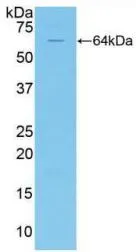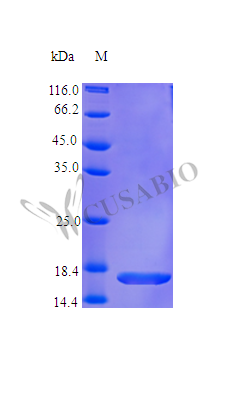
WB analysis of GTX00080-pro Human Fas protein.
Human Fas protein, His and MBP tag
GTX00080-PRO
ApplicationsFunctional Assay
Product group Proteins / Signaling Molecules
Protein IDP25445
Overview
- SupplierGeneTex
- Product NameHuman Fas protein, His and MBP tag
- Delivery Days Customer9
- Application Supplier NoteFAS (Tumor necrosis factor receptor superfamily member 6) belongs to the tumor necrosis factor receptor superfamily. FAS contains a death domain, which has been shown to play a central role in the physiological regulation of programmed cell death. A binding ELISA assay was conducted to detect the association of FAS with TNFa. Briefly, FAS were diluted serially in PBS, with 0.01% BSA (pH 7.4). Duplicate samples of 100 microl FAS were then transferred to TNFa-coated microtiter wells and incubated for 2h at 37C. Wells were washed with PBST and incubated for 1h with anti-FAS pAb, then aspirated and washed 3 times. After incubation with HRP labelled secondary antibody, wells were aspirated and washed 3 times. With the addition of substrate solution, wells were incubated 15-25 minutes at 37C. Finally, add 50 microl stop solution to the wells and read at 450nm immediately. The binding activity of FAS and TNFa was in a dose dependent manner.
- ApplicationsFunctional Assay
- CertificationResearch Use Only
- ConjugateUnconjugated
- Protein IDP25445
- Protein NameTumor necrosis factor receptor superfamily member 6
- Scientific DescriptionThe protein encoded by this gene is a member of the TNF-receptor superfamily. This receptor contains a death domain. It has been shown to play a central role in the physiological regulation of programmed cell death, and has been implicated in the pathogenesis of various malignancies and diseases of the immune system. The interaction of this receptor with its ligand allows the formation of a death-inducing signaling complex that includes Fas-associated death domain protein (FADD), caspase 8, and caspase 10. The autoproteolytic processing of the caspases in the complex triggers a downstream caspase cascade, and leads to apoptosis. This receptor has been also shown to activate NF-kappaB, MAPK3/ERK1, and MAPK8/JNK, and is found to be involved in transducing the proliferating signals in normal diploid fibroblast and T cells. Several alternatively spliced transcript variants have been described, some of which are candidates for nonsense-mediated mRNA decay (NMD). The isoforms lacking the transmembrane domain may negatively regulate the apoptosis mediated by the full length isoform. [provided by RefSeq, Mar 2011]
- Storage Instruction-20°C or -80°C,2°C to 8°C
- UNSPSC12352202



